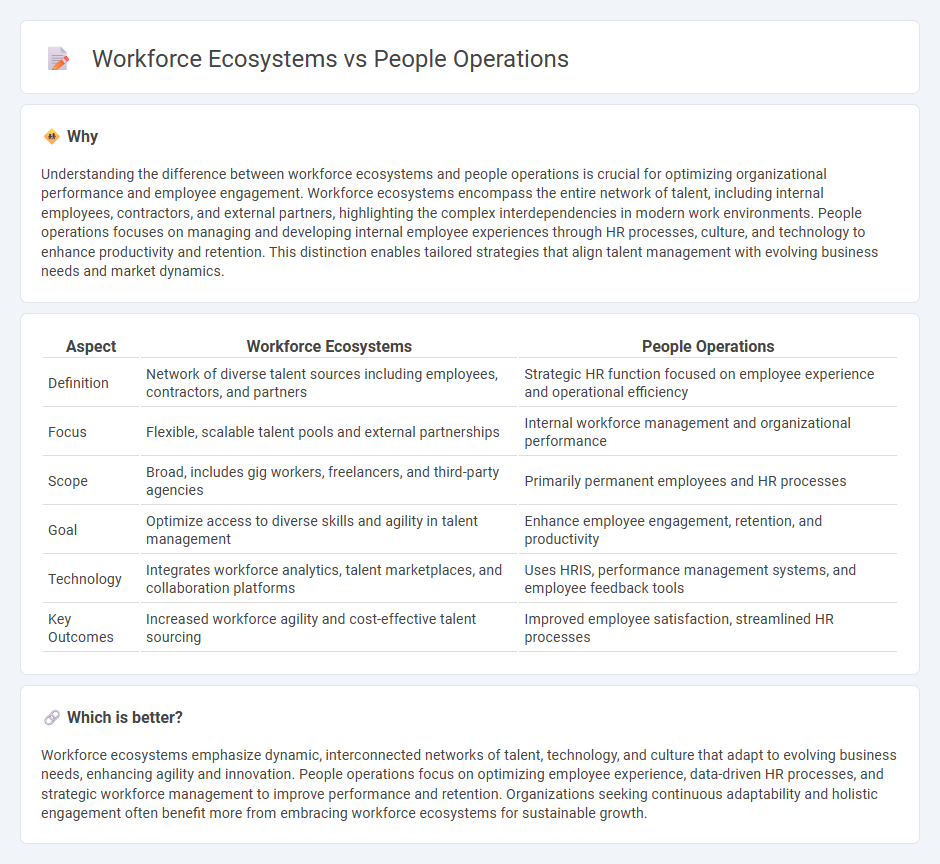
Workforce ecosystems integrate diverse talent sources, technologies, and partnerships to create agile and scalable human resources models. People operations focus on optimizing employee experience, engagement, and performance through data-driven HR practices and strategic workforce management. Explore how aligning workforce ecosystems with people operations drives organizational success and innovation.
Why it is important
Understanding the difference between workforce ecosystems and people operations is crucial for optimizing organizational performance and employee engagement. Workforce ecosystems encompass the entire network of talent, including internal employees, contractors, and external partners, highlighting the complex interdependencies in modern work environments. People operations focuses on managing and developing internal employee experiences through HR processes, culture, and technology to enhance productivity and retention. This distinction enables tailored strategies that align talent management with evolving business needs and market dynamics.
Comparison Table
| Aspect | Workforce Ecosystems | People Operations |
|---|---|---|
| Definition | Network of diverse talent sources including employees, contractors, and partners | Strategic HR function focused on employee experience and operational efficiency |
| Focus | Flexible, scalable talent pools and external partnerships | Internal workforce management and organizational performance |
| Scope | Broad, includes gig workers, freelancers, and third-party agencies | Primarily permanent employees and HR processes |
| Goal | Optimize access to diverse skills and agility in talent management | Enhance employee engagement, retention, and productivity |
| Technology | Integrates workforce analytics, talent marketplaces, and collaboration platforms | Uses HRIS, performance management systems, and employee feedback tools |
| Key Outcomes | Increased workforce agility and cost-effective talent sourcing | Improved employee satisfaction, streamlined HR processes |
Which is better?
Workforce ecosystems emphasize dynamic, interconnected networks of talent, technology, and culture that adapt to evolving business needs, enhancing agility and innovation. People operations focus on optimizing employee experience, data-driven HR processes, and strategic workforce management to improve performance and retention. Organizations seeking continuous adaptability and holistic engagement often benefit more from embracing workforce ecosystems for sustainable growth.
Connection
Workforce ecosystems integrate diverse talent sources, technologies, and organizational processes that drive agile people operations, enhancing employee experience and operational efficiency. People operations utilize data analytics and HR technology to optimize workforce planning, recruitment, and performance management within these ecosystems. This interconnected approach fosters adaptability, innovation, and employee engagement, aligning human capital strategies with business objectives.
Key Terms
**People Operations:**
People Operations centers on optimizing employee experience, talent management, and organizational culture using data-driven strategies and HR technology. It integrates recruitment, onboarding, performance management, and employee engagement to foster productivity and retention. Explore the latest trends and best practices in People Operations to elevate your HR strategies.
Employee Experience
People operations prioritize streamlining HR processes and enhancing employee engagement through data-driven strategies and personalized support systems. Workforce ecosystems emphasize integrating diverse talent pools, technology platforms, and external partners to create a seamless, flexible employee experience. Explore how aligning these approaches boosts retention and drives organizational success.
Talent Management
People operations centers on optimizing employee experience, engagement, and performance through strategic talent management practices such as recruitment, onboarding, and development. Workforce ecosystems expand this scope by integrating external partners, technology platforms, and contingent labor to create a flexible, collaborative talent environment. Explore the nuances and benefits of each approach to enhance your organization's talent strategy.
Source and External Links
People Operations: A Guide to the New HR Term You Should Know - People operations focuses on enhancing employee success and productivity by leveraging HR data, improving employee experience, and creating results-oriented retention strategies, with a shift toward viewing employees as internal customers.
People Operations: 9 Key Responsibilities - People operations connects individual performance to company goals, maps and optimizes the employee journey, and ensures consistency and support throughout the employee lifecycle to foster an inclusive work culture.
Everything You Need to Know About People Operations Jobs - People operations roles involve updating HR systems, increasing employee satisfaction, analyzing HR metrics, onboarding new hires, empowering teams, and reporting data-backed insights to leadership.
 dowidth.com
dowidth.com